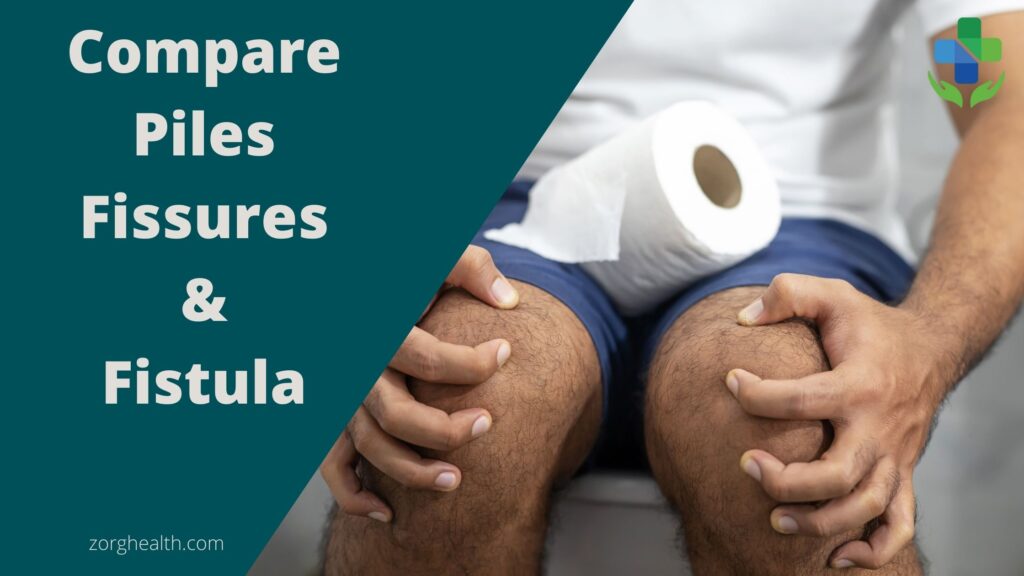In this article, we compare Piles, fissures, and fistula.

Piles
Piles are also known as hemorrhoids. They are very common but people are afraid and shy to discuss them. The incidence of piles can never be known precisely as people tend to avoid discussing it. Pile is a name given to a condition in which there is swelling in and around your back passage.
There is small blood carrying vessels in and around ANUS (opening at the back of your bottom from where stools are passed out), in piles, they get swollen and lead to bleeding from the anus. Pain is often accompanied by bleeding. It is said that piles can affect up to 75% of the population by they reach 50.
Types of Piles
There are two types of piles –
Internal piles– rectum is the last part of your intestine where stool is stored this part then connects to the anal canal (3-5 cm long) and this junction is called a DENTATE LINE. When there is swelling of blood vessels near the end of the rectum or above the dentate line then this is called internal piles. Although the name says internal sometimes, they can prolapse and protrude out of the anus and look like external piles.
External piles- pile formation below the dentate line is called external pile. These are more painful as there are more nerves supplying below the dentate line.
How will you know if you have piles?
The most common symptom is bleeding during or after passing stools. Most often this is fresh thin blood but sometimes there can be clots of blood as well. The majority of times piles are not visible but sometimes they can protrude out as discolored soft lumps in or around the anal orifice. Other symptoms can be-
- Painful swelling around the anus (more with external piles)
- Incomplete evacuation of stools or feeling full bowel after passing stools.
- Bright red fresh thin blood after passing stools.
- Pain while passing stools.
- Soreness or itching around the anus.
- Sticky discharge in your underwear or during wiping with a tissue.
What causes piles?
When there is more pressure to the lower bowel then there are more chances of piles developing. The commonest causes are-
- Constipation
- Heavyweight lifting
- Pregnancy
- Straining during defecation
- Aging, as the lining may become weaker as one age.
- Persistent cough
- Hereditary, few individuals just have inherited weakened walls of blood vessels around the anus.
Are Piles serious?
In the majority, they disappear themselves. Even if they don’t, they are not serious. However, they can cause serious trouble if due to piles there is-
- Bleeding that leads to anemia
- Anal fistula (there forms another connection between the anal canal and outer skin)
- Blood clot (causing thrombosis and pain) or strangulation in hemorrhoid leads to infection
- Bowel incontinence (when you can’t control bowel movements and stools leak unexpectedly)
How is pile treated?
The majority get relief on their own piles doesn’t even need treatment sometimes. But to rule out the severity of the disease one must visit a doctor if suffering from a long duration or having any of the above-mentioned complications of piles. Options to treat piles are-
- A healthy diet that reduces body weight and eliminates constipation
- Drugs to help in constipation such as laxatives
- Surgery – there are many options nowadays to remove piles surgically and these are –
- Banding – most commonly done, in this band is applied at the base of hemorrhoids which cuts off the blood supply.
- Sclerotherapy- the chemical is injected at the base of hemorrhoids to cause a fibrotic reaction.
- Coagulation- a beam of infrared light is used to stop supply to hemorrhoid.
- Stapling- circular staple used to staple pile at the base.
- Hemorrhoidectomy- Surgical removal of the pile.
Dos and Dont’s for piles
Here is what you should do
- Drink plenty of water and eat high fiber diet
- Frequently wipe your anal area with moistened tissue
- Warm sitz bath
- You can try to gently put prolapsed piles back
- Avoid alcohol and drinks which lead to dehydration
Here are the things you should avoid
- Never postpone defecation
- Don’t strain much while defecation
- Avoid ibuprofen
- Avoid wiping your bottom too hard
Anal fissures
Fissure by definition means tearing of tissue. Any visible tear or cut around the anus is called an anal fissure. Fissure is a very painful condition.
What leads to fissure?
Similarly, like piles increased pressure during defecation can lead to fissure formation. Causes are-
- Hard stools
- Constipation
- Heavy exercise or weight lifting
- Inflammatory bowel disease (Crohn’s disease)
- Excessive use of laxatives
- Sexually transmitted disease
When to suspect fissure?
- If you feel intense pain before during or after passing stools, pain can even last for up to 4-6 hours after defecation.
- Visible cut or tear around the anus.
- Clotted blood near the anus.
How serious can anal fissure be?
Fissures rarely can sustain for more than 8 weeks, if they do, they may need surgical treatment. Sometimes they extend to surrounding muscle and tissues and won’t heal at all.
Treatment of fissure
The majority of fissures need conservative treatment like creams, sitz baths, antibiotics, etc. Rarely some surgical intervention may be needed.
Fistula
The fistula is a connection between the anal canal and the outer skin. As they are kind of a tunnel with an opening on the outer skin, pus discharge becomes the main symptom of fistula.
What is the cause of fistula?
There are glands in the anal canal and if they get infected it causes anorectal abscesses which means there is a cavity filled with pus inside the anal canal. Sometimes these abscesses connect to the outer skin and form a tract.
Symptoms of fistula
- Pus discharge from opening surrounding anus.
- Pain and swelling in the anal region.
- Irritation around anus
- Painful defecation
- Fever
Treatment of fistula
Your doctor might run some tests on you like –
- Proctoscopy or sigmoidoscopy- light beam or fiber-optic camera is used to see rectum from inside
- Endorectal USG (ultrasound)- sound waves are used to identify fistula tract
- Fistulography- dye-assisted x-ray to find out a tract.
Once the tract has been identified which can be single or multiple, the doctor may advise you –
- Fistulotomy- opening the track to the outside to let heal itself
- Fistulectomy-complete removal of the fistula tract
- Fibrin glue
- Ligation of inter sphincteric fistula tract- LIFT
- Fistula tract LASER closure- FiLaC
So piles, fissures, and fistula are all conditions affecting the anal canal. But they all are different and one should seek medical help to diagnose and treat them properly. This is how you can compare Piles fissures and Fistula and seek its treatment.
